In the realm of manufacturing maintenance, efficiency is paramount. Every minute of downtime can translate into lost revenue and decreased productivity. That’s where Maintenance Planning & Scheduling comes into play. Maintenance Planning & Scheduling is not just a routine task; it’s a meticulous process that ensures optimal resource allocation, timely execution, and maximum equipment uptime. Let’s delve into the four key stages of Maintenance Planning & Scheduling and explore their significance in maintaining a well-oiled manufacturing facility.
1. Input: Building the Foundation
The journey begins with compiling a comprehensive list of workload recorded via Work Orders in the Computerized Maintenance Management System (CMMS). This initial step underscores the importance of having high-quality, up-to-date maintenance documentation. By meticulously managing work order statuses, maintenance professionals gain invaluable insights into the status of each task, facilitating better decision-making and prioritization.
To enhance the Input stage, organizations should invest in robust CMMS systems that offer comprehensive tracking and reporting capabilities. These systems should allow for easy data entry, facilitate real-time updates, and provide insights into maintenance trends and patterns. By leveraging technology, organizations can streamline data management processes, minimize manual errors, and lay a solid foundation for effective maintenance planning and scheduling.
2. Planning: Laying Out the Blueprint
Once the groundwork is laid, planning takes center stage. This phase involves identifying the scope, duration, resources, and necessary parts for each task. Backlog management becomes a critical component here, ensuring that no maintenance request slips through the cracks.
Detailed work requests are the cornerstone of the Planning stage. Each work request should include comprehensive information about the job scope, scheduled hours, required parts, manpower, special tools, and status. Special attention should be given to technical specifications and safety requirements to ensure that tasks are completed safely and efficiently.
In addition to detailing work requests, Planning also involves proactive resource management. This includes placing orders for parts, tools, or external services well in advance to avoid delays and minimize downtime. By anticipating maintenance needs and stocking up on essential supplies, organizations can ensure smooth execution and minimize disruptions to operations.
To optimize the Planning stage, organizations should adopt a structured approach to backlog management. This may involve categorizing maintenance requests based on priority, criticality, and resource availability. By segmenting the backlog, maintenance planners can allocate resources more effectively, prioritize high-impact tasks, and minimize downtime.
3. Scheduling: Balancing Act
With the blueprint in place, the next challenge lies in balancing the workload against available resources. Scheduling involves defining which tasks are to be completed, when, and by whom, all while optimizing resource utilization. By striking the right balance between demand and capacity, maintenance professionals can ensure that critical tasks are prioritized, downtime is minimized, and resources are utilized efficiently. Through effective scheduling, manufacturing facilities can maintain operational agility and respond promptly to evolving maintenance needs.
Another important aspect of scheduling is managing downtime effectively. This includes planning and scheduling downtime activities such as preventive maintenance, inspections, and repairs to minimize disruptions to production. By coordinating downtime activities with production schedules and other maintenance activities, organizations can optimize resource utilization and minimize downtime.
To enhance the Scheduling stage, organizations should leverage scheduling tools and software that offer advanced scheduling capabilities. These tools should allow for real-time scheduling, resource allocation, and conflict resolution, enabling maintenance teams to optimize schedules and minimize downtime.
To see how scheduling fits into the broader types and strategies of maintenance, explore the complete guide to industrial maintenance.

4. Execution: Bringing Plans to Life
Execution is where the rubber meets the road. Here, the emphasis is on safe, high-quality job execution, driving efficiency, and maximizing the productivity of the maintenance crew. Parts are kitted and staged for easy access, streamlining the execution process. Daily progress is reported, allowing for real-time insights into what’s working well and where improvements can be made. Validation ensures that all work meets required quality standards, with feedback loops ensuring continuous improvement.
Communication is also key during the Execution stage. Maintenance teams should communicate regularly with each other and with other stakeholders to coordinate activities, share information, and address any issues or concerns that arise. By maintaining open lines of communication, organizations can ensure that everyone is on the same page and that tasks are completed efficiently and effectively.
It’s essential to note that while Maintenance Planners play a crucial role in the planning and scheduling process, they are not responsible for managing emergency breakdowns or issues. The Maintenance Planner’s primary focus should always be on future planning, ensuring that maintenance activities are planned, scheduled, and executed efficiently to prevent unplanned downtime and maximize equipment reliability.
By maintaining a future-focused mindset, Maintenance Planners can proactively identify maintenance needs, anticipate resource requirements, and optimize maintenance schedules to minimize disruptions to production. This forward-thinking approach enables organizations to stay ahead of maintenance challenges, mitigate risks, and maintain a competitive edge in today’s dynamic manufacturing landscape.
In conclusion, Maintenance Planning and Scheduling is a critical aspect of manufacturing operations. By following the four pillars of Maintenance Planning and Scheduling – Input, Planning, Scheduling, and Execution – organizations can optimize maintenance activities, minimize downtime, and maximize operational efficiency. By investing in robust processes, tools, and technologies, organizations can streamline their maintenance operations and achieve sustainable growth in today’s competitive marketplace.
This efficiency becomes sustainable only when grounded in strong fundamental practices. Discover more in Back to the Basics: Unveiling the Power of Fundamental Maintenance Practices.
- Ready to transform your Maintenance Planning & Scheduling process? Schedule a free 1:1 call with our experts today and unlock the full potential of your operations. Let’s collaborate to elevate your facility’s efficiency and uptime. Book your session now.










